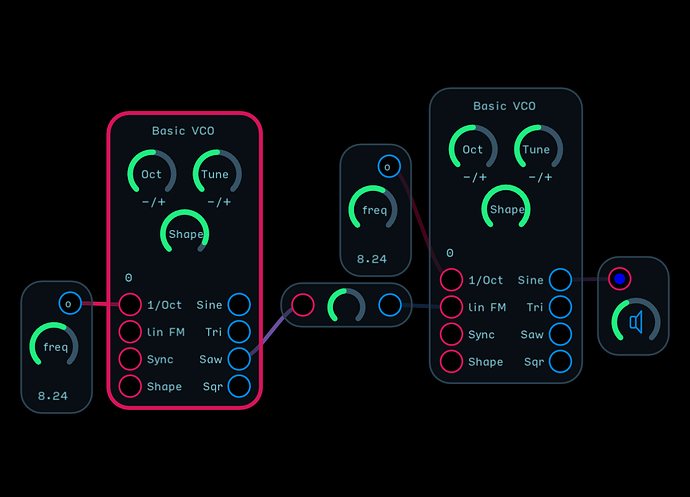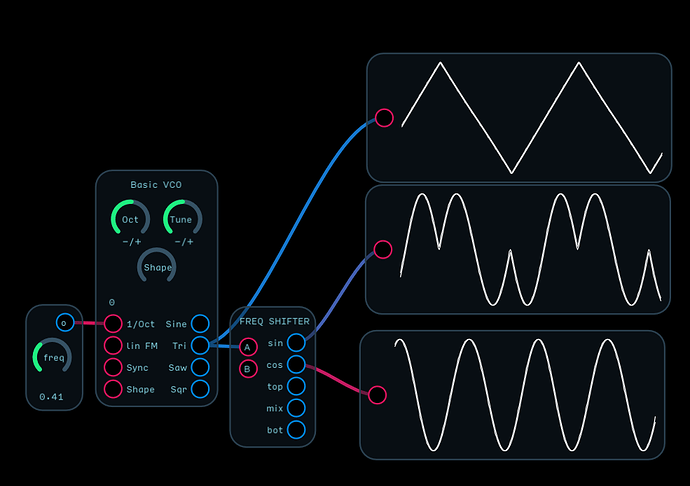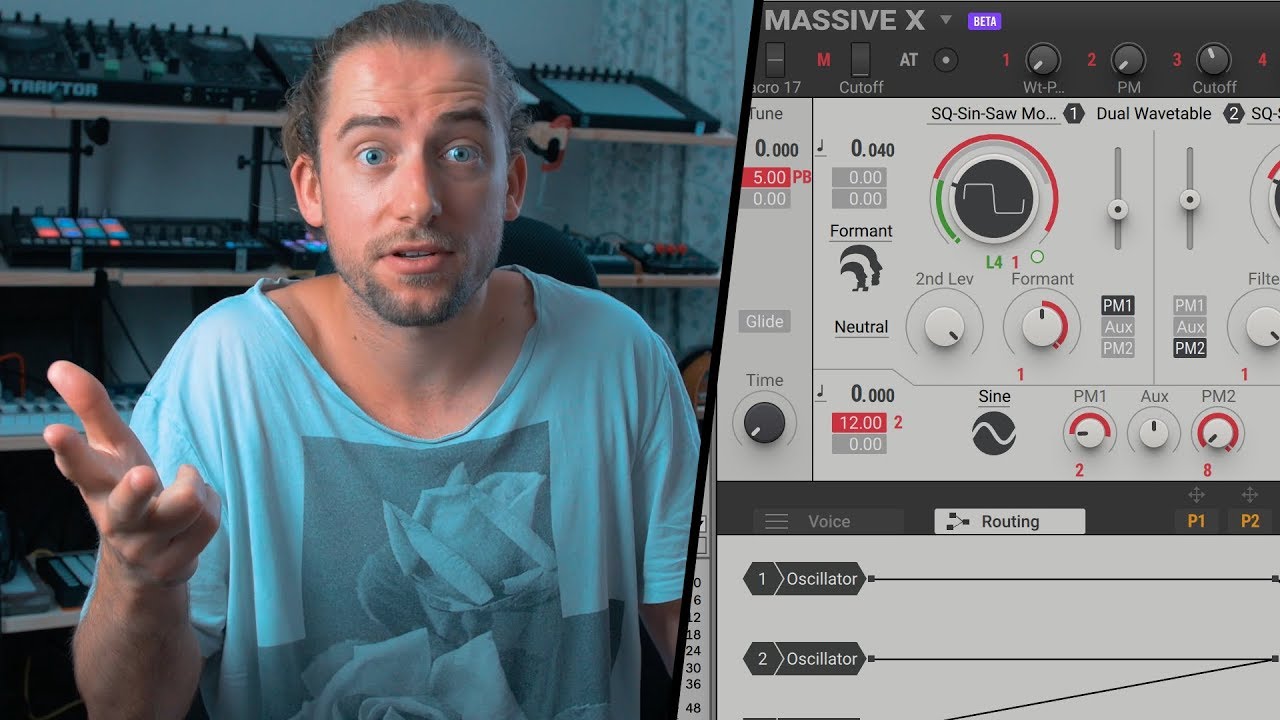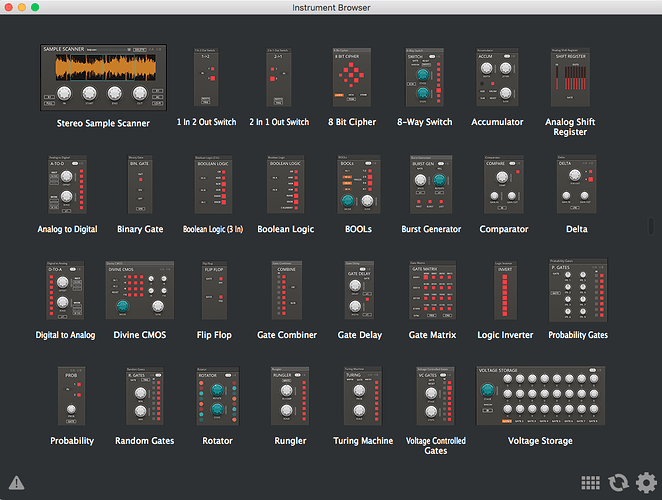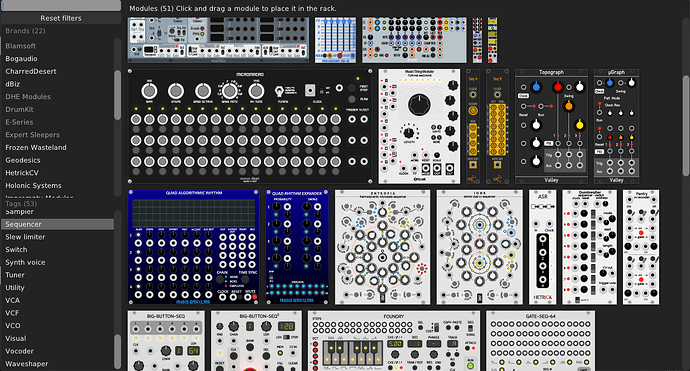I suggest the Make Noise LXD for your purposes. It is inexpensive, small, analog, “west coast,” not too intricate, very versatile, and has a sonic character that really stands out when you hear it in person. If one was to build a very small rack, you could use this + an ES-8 and have some serious sound. It pairs extremely well with the Pulp Logic Cyclic Skew, IMO.
Thats a real nice sounding module and a great video! Thanks for sharing 
Here are some rough drafts - don’t take anything from the UI, that will change - this is really just trying to work out what the controls and I/O are for each type of module (also note they’re non-functioning).
Audulus 4 Module Outlines v1.audulus (22.9 KB)
They look pretty good. I notice you’ve gone back to the I/O at the bottom layout as well as more verbose labels. I think both are probably good ideas particularly for newbies. A couple of the labels are a bit obscure. I would replace cut with freq. and I’m not sure what the cosin output on the VCA is for. Cosine perhaps? An interesting idea but probably a bit obscure for a basic unit. (Hmmm, I wonder what you would get if you took an audio signal, multiplied by pi and took the cosine?) 
I think that one way to approach things is to release in flavours or collections. These chainables are really fun. I would like to see more of this.
What is a crossfade VCO? Is that a spline-based wavetable thinggie?
At least one of the oscillators needs a traditional linear FM input with a pretty modest index of modulation. Additionally, bipolar knobs should have some indicator that the default is in the middle rather than at zero.
As a side note I hope we can keep the 1/Oct inside Audulus. VPO is cool and all but it’s another layer of conversion away from Hz, which I notice that pretty much everybody in MAX and Pd use.
Lin FM Basic Audulus 4 Osc.audulus (51.0 KB)
For some reason, I made a little demo osc to show what I meant. I forget what you were planning to do with the shapes, so I just did my favorites.
BTW I think this could be a good idea for a give-away. Just post a module with a finished UI but nothing inside and have the contest be to build how you think the module should work. That could just be me being a nerd though.
I second this. The Audulus equivalent of 14HP for the basics modules is really friendly to people learning Audulus. Clear, uncluttered, consistent designs will guide users into the audulus workflow and eventually they will pick up the more compact abstract uModules.
I also agree “Freq” is more common when labeling cut off frequency.
You silly goose, we did that already in 90 degree all pass filter thread. I actually really like the effect.
Freq Shifter takes Cos of Input.audulus (31.8 KB)
It’s where you crossfade between two waveshapes at audio rate. I’m actually making it right now and will upload it tonight.
There’ll definitely be more VCOs, including a basic FM one - this is just some of them I was sketching up.
Yeah definitely - these will honestly a lot of them be faders instead of knobs, so they’ll have SVG markings on the side.
I think we should just shift the scaling so that 0 = lowest note, not A440. That way it will resemble VPO more and be easier for others to pick up.
As for Max and Pd - do you mean they use Hz? The only problem with Hz is that it’s non-linear and hard to manipulate with LFOs and simple scaling math.
haha I was just copy/pasting the modules and changing the names of I/O - forgot about that one! And yeah I just did cut cause I was blanking on Freq and looking for something to fit inside the knob. For the most part these aren’t to show what the labels will look like or whatnot, it’s more about the functionality - what can be controlled, what are inputs and ouputs, etc.
That would be awesome!
I think you mean the opposite. Hz is linear and out perception of pitch is logarithmic, so we think about raising and lowering semitones as if they were linear. Max and Pd have no problem making you do the math on hard mode ![]() , but I think what goes on is that they send around midi note numbers and then convert to Hz right before the oscillator. They use a standard frequency lookup table and adding midi notes is intuitive in the same way as semitones.
, but I think what goes on is that they send around midi note numbers and then convert to Hz right before the oscillator. They use a standard frequency lookup table and adding midi notes is intuitive in the same way as semitones.
That said, the fewer competing soft standards there are within the library the better.
Yeah, but comparatively, jumping an octave in Hz is exponential vs. the linear jump from 0 to 1.
This creates a linear pitch space in which octaves have size 12, semitones (the distance between adjacent keys on the piano keyboard) have size 1, and A440 is assigned the number 69.
From this (describing MIDI): Pitch (music) - Wikipedia
Speaking of which, would it make sense to basically follow the MIDI scheme, where 0 = C-1? I know that MIDI is working in units of 1 instead of 1/12, but it might be a useful reference point. Perhaps is should be C0?
@biminiroad I figured it was something along those lines. @robertsyrett I totally forgot about the Freak Shifter. On the subject of knobs and sliders, I would love to see an option to have one that returned to center when released. Or alternatively the ability to set a knob/slider from an input. Max is very flexible in that area. I’ve been plowing through the Max/DSP tutorials and I see a lot of things that would make programming in Audulus easier. Audulus is definitely more abstract than Max (which is a good thing in my opinion), but there are times when having a defined order of execution would be nice. I think Taylor’s real challenge is keeping the simplicity of the current version of Audulus while coming closer to the functionality of Max/DSP. (BTW the current version of Max for Live isn’t as stable as Audulus despite the huge difference in price.)
That should definitely be coming. It’s essential for pitch wheel type stuff.
What do you think could make that easier in Audulus? Do you mostly run into this problem with feedback loops?
This seems reasonable. That’s what all my other Midi-CV gear does and it seems like the industry standard. The big downside is that there is some rounding to the lookup table. So C9 is 8372.02 Hz, which is obviously not an even multiple of C1(32.70Hz). Since everything in even temperament revolves around the nice even multiple of 440 there will be some minute amount of detuning unless we go with a very accurate measure of low C. The Irony is that I pretty much never tune exactly to low C in eurorack, but somehow when it’s in Audulus I want the pitch to be perfect.
I’m perfectly happy with A440 == 0. It’s kind of an international standard for tuning and the transposition is trivial. Anyone that wants to adopt a different zero point only has to do a simple addition. For Eurorack gear it might make sense but by the time you interpose a scaling module for your ES-8 or similar it really doesn’t matter.
Just curious, is there any sort of rough ETA for A4? I don’t really mean in terms of a date but is it on the order of the next few months, before the end of the year or just totally unknown?
Before the end of the year is the only ETA right now. It’s definitely going to be worth the wait though! ![]()
Some interesting UI considerations/developments from iZotope:
https://www.izotope.com/en/learn/products/neutron/izotope-product-design-creating-the-gauge.html
Speaking of UI developments, I think it is very important to pay attention to Native Instruments reface of Massive. Luckily we get a thick review from one of the most creative, transparent youtube based music producers:
WARNING! THIS VIDEO MAY ANNOY YOU VERY MUCH. USE CAUTION.
- I want to add as well; look, IMO we are in a time of abundance which usually requires some discipline. That is, a lot of the techniques and flashy synths are not that innovative. They just have nice packaging, form factors etc. – which is important. However, so much of this has been happening with NI Reaktor. I believe that one of the reasons that Reaktor is so far reaching is because the user interface for curating everything has been taken very seriously.
A user created a great little tool called “instrument browser” that allowed you to see all of the modules in graphic form so when you are in your workflow you can just draw from a visible shelf of modules.
In the new VCV Rack 1.0 release, they managed to do the exact same thing, but since the platform itself integrated the feature, the full feature set has a nice balance b/w texted based archiving and visual representation.
It has always bothered me that people make these beautiful modules in Audulus and they get buried and forgotten. That’s why I have been trying to create patches with the modules and share them.
So I guess I am hoping there is some interest in providing the tools for the builders to create tools that utilize visual graphic representation techniques to aid in understand complex synthesis. I think the new Massive X is a great example of this moving forward.
Of course, if you watch the Massive X review you will get to some heavy criticism about visual feedback. So, @taylor, I think this is a great opportunity and I imagine you probably have the background to consider such things, given you career in graphics.
@futureaztec We’re working on an improved module browser for A4, which will be a full-screen sort of thing, with images. ![]()
